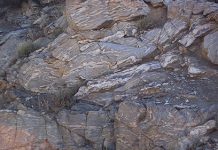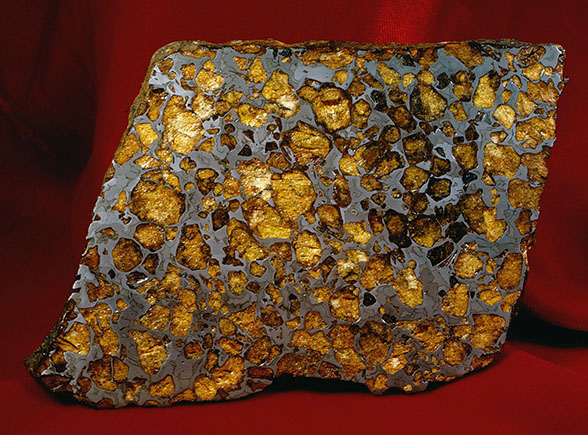
Story by Bob Jones
Meteorites are fascinating things. These space rocks are fragments broken from asteroids or comets traveling through inner space. When the fragments, known as meteoroids, enter Earth’s atmosphere, the resulting friction generates intense heat. Their path to the planet’s surface is marked by a blaze of light, called a meteor, whose appearance inspired the term “shooting star”. Meteoroids that contact Earth’s surface become meteorites. Oddly, eyewitness reports of freshly fallen meteorites vary. Some report that they are so hot they will convert water to steam. Others tell of frost forming on a fresh fall because it is so cold.
They are not to be confused with comets, which are massive chunks of frozen material—including dust, ice, carbon dioxide, ammonia and methane—that orbit the sun in a far plane that surrounds our solar system. As they pass near the sun, solar radiation and solar wind act upon them to alter their outer layers into a gaseous state. These gasses form coma around the ice ball that gives the comet its fuzzy appearance. Gasses and dust particles follow in the comet’s wake, forming a “tail”.
Falling meteors may break the sound barrier, creating a booming sound that is often reported by observers. The intense heat caused by friction often leaves shallow depressions on the meteor’s surface that scientists call regmaglypts and laymen call thumbprints. It is not unusual for a meteor to actually explode before landing. This scatters chunks in a more or less oval pattern, elongated in the direction of travel, and can even create a crater of good size.
While most meteors disintegrate into tiny particles before they hit the ground, enough sizeable specimens have been recovered to allow scientific study. From this, researchers have come to better understand the universe and our Earth.
Science has classified meteorites in three general categories, each with subdivisions. The general forms are nickel-iron, stony iron, and stony, names that give a broad description of their composition. We have been able to further divide these three groups based on mineral composition and structure.
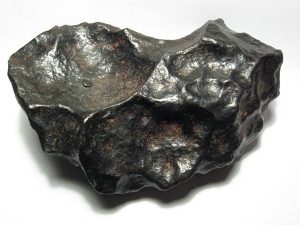
Of the three meteorite types, the easiest to find and recognize are the nickel–irons. These two metals, which account for the bulk of their composition, are somewhat resistant to weathering, since they develop a protective iron oxide crust on their trip through the atmosphere. They can contain trace amounts of minerals—even diamond, a form of carbon, in rare cases.
Solid-metal meteors tend to survive the atmosphere and land on Earth. Their unusual surface features make them easy to recognize, so you would think they are the more common of meteorite falls. Not so! Nickel-iron meteorites represent only about 5% of all Earth’s meteorites, but because they are the easiest to recognize, they are the more common type in collections and displays. The most common type of meteor that falls toward Earth must be one of the remaining types: stony iron or stony.
A very small percentage (1% or 2%) of falls, as they are called, are composed of both metal and stone. These are the stony irons. The stony meteorites are by far the most common falls, making up well over 90%. So why don’t we see more stony meteorites on display? There are several reasons.
As mentioned, the nickel-irons are comparatively easy to spot, so more of them are recovered. Stony meteorites are far more difficult to identify, as they look a lot like Earth rocks. I sometimes get a photo sent to me of what is thought to be a meteorite that turns out to be a piece of slag, volcanic rock, bog ore, or cinder. Stony meteorites have a dark-gray to black surface. They have no protective surface coating to protect them from weathering, so they deteriorate more easily and blend into surrounding rocks. Our best finds are made in the frozen regions of the planet or in a desert, where the meteorites are distinctly different from their surroundings.
A meteor strike may also produce tektites, small, rounded pieces of black glass that are found in definite patterns around some impact areas. The largest area seems to be in Southeast Asia, where studies have shown the tektites—thousands of them—were probably ejected when a huge meteor smashed into the moon. That collision created one of the most obvious craters, Tyco, on our nearest neighbor.
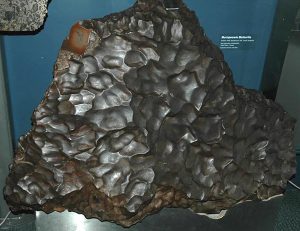
Pieces of this material were ejected far enough for Earth’s gravity to capture them. The area in which the tektites are found includes Hainan Island, off the coast of China. My friend John K.K. Lee visited that island with a friend who helped him collect pieces of tektite. John sent one to me, along with documentation that NASA had analyzed it and determined that it had originated on the moon. They did this by comparing the tektite to information sent back to Earth by a moon lander.
The importance of meteorites is largely overlooked by folks who see them in museums and at mineral shows. They are seen as curiosities and not much more.
Astronomical studies of asteroids, based on meteorite composition and space exploration, have shown that some asteroids have three distinct zones: a metal core, an outer stony crust, and a mix of metal and stone in between. This also describes the three general types of meteorites we have here on Earth, but how does this relate to our planet’s structure?
The deepest holes dug by humans only penetrate a few miles into Earth’s crust. The Russians drilled a shaft about eight miles deep. The deepest mines are in South Africa, and they are up to five miles deep. Temperatures at this depth are brutally hot. I’ve been nearly a mile underground in an Arizona mine, where the rock temperature was close to 150°F. I can’t imagine what it is like five miles down. Yet, we have a very good idea what Earth’s interior is like, right to the core itself. We use seismic waves generated by earthquakes and even atomic explosions to get a good picture of this internal structure.
When a major earthquake occurs, the planet rings like a bell. It sends different types of vibrations radiating in all directions. What’s important is that all rocks do not vibrant or transmit vibrations exactly the same way. Solid rock responds to these vibrations in one way, while rock that is in a plastic or liquefied state responds differently. We can emulate these responses in a laboratory to determine the type and condition of the rock.
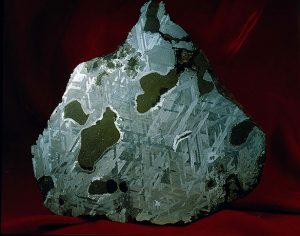
Earth has a solid-metal core surrounded by a molten-metal outer core. Above this is what we call the mantle, which is made up of very dense rock with some metal. On top of the mantle floats the less dense surface crust, which is just a few miles thick. Volcanic rock from deep inside the planet confirms these finds. We find high-temperature minerals in volcanic rock of deep origin and minerals that form at much lower temperatures in crustal rocks.
To confirm these findings, we have the three general meteorite types, which closely match the evidence of Earth’s zoned structure. The study of the minerals in meteorites, asteroids, and even comets is far more detailed and forms a solid basis for this generalized description of our planet’s interior.
What is really interesting is that both comets and meteorites are capable of changing the course of human history. Before science proved what meteorites really are, humans created their own explanations and assigned all sorts of meanings to them. The general consensus was that they originated with the gods. Some believed these space objects portended doom, while others saw them as positive omens.
In 1066, the Normans, who thought their leader Duke William was the rightful king of England, were squaring off against the Anglo-Saxons, led by King Harold, in what history would call the Battle of Hastings. When a celestial object was seen blazing across the sky, the Normans considered it a good omen. The Anglo-Saxons, however, considered the space object a sign of doom. Duke William prevailed in the battle, killing King Harold. Re-dubbed William the Conqueror, he became England’s rightful king. This harbinger, which was later proved to have been what we know as Halley’s Comet, made a major impact thanks to the power of superstition.
A wonderful example of the effect of space objects on mankind and religion can be found at Mecca, in Saudi Arabia, the birthplace of Mohammed and the spiritual center of Islam. Housed in a shrine called the Kaaba is The Black Stone, which is believed to be a gift from the Angel Gabriel. Mohammed is said to have handled the relic and placed it in the Kaaba, where it resides today. Muslims make an annual pilgrimage, or hajj, to touch and kiss this revered object.
I’ve always had a fascination of meteorites, probably because I grew up on a small farm in Connecticut, where the clear night air revealed the heavens to me. Shooting stars, as we called them, seemed magical and we made wishes on them. When I had the chance to see and actually touch meteorites displayed at museums, it brought shooting stars to life for me. This may be why I insisted on visiting the Hoba meteorite in Namibia when Dick Bideaux and I planned a mineral trip to Tsumeb.
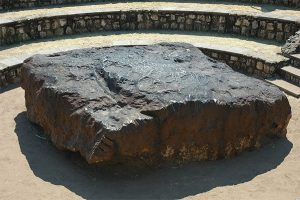
The Hoba meteorite is the largest known meteorite on Earth. It weighs about 65 tons, which probably explains why it is still sitting in a rancher’s field. In fact, it is so well known that it has been encircled by a nicely built stone terrace, with restrooms nearby.
The Hoba is a nickel-iron type and measures over 8 feet across. It shows the usual thumbprints, but they are quite shallow. It also shows chop and saw marks where people have tried to remove a small souvenir.
As huge as this nickel-iron giant is, its origin is something of a mystery. Since it hit the ground a little under 80,000 years ago, there was nobody around to witness or record the event. No one has been able to explain how this monster came through the atmosphere nearly unscathed. When huge meteors penetrate Earth’s atmosphere, they build up a huge compression wave in front of them. They heat up to the melting point of the metal and very often explode into fragments, which scatter over the landscape for a great distance. Even if they remain intact when they hit the ground, they blast out a significant crater.
Instead of hitting the surface at the speed of sound, as many large falls do, the Hoba seems to have hit quite gently. There isn’t even a noticeable crater made by its arrival. It rests in a shallow depression, indicative of a reasonably slow approach and landing.
Oddly enough, meteorites may be easy to find. I learned in school that, if you gather all the dust particles in your home’s rain gutters and examine them under a microscope, you just might see tiny, dark, round grains that could be micrometeorites, which are constantly raining down from space. In fact, Earth gains tons of space debris every day. As a rockhound, keep an eye out for any rock that does not belong where it is. You just might have found a gift from the gods!



